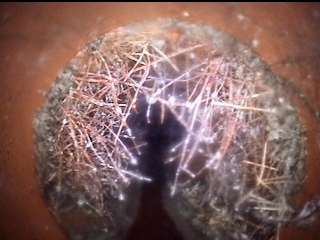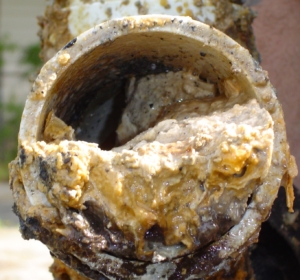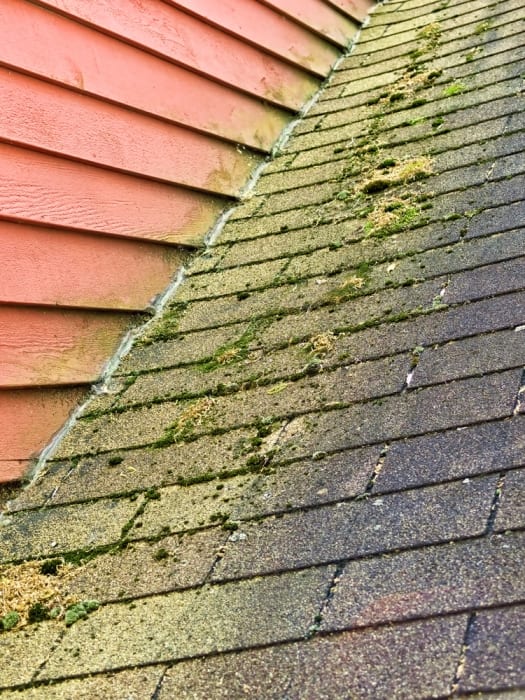Roofs play a key role in protecting building occupants and interiors from outside weather conditions, primarily moisture. The roof, insulation and ventilation must all work together to keep the building free of moisture. Roofs also provide protection from the sun. In fact, if designed correctly, roof overhangs can protect the building’s exterior walls from moisture and sun. The concerns regarding moisture, standing water, durability and appearance are different, reflected in the choices of roofing materials.

Maintaining Your Roof
Homeowner maintenance includes cleaning the leaves and debris from the roof’s valleys and gutters. Debris in the valleys can cause water to wick under the shingles and cause damage to the interior of the roof. Clogged rain gutters can cause water to flow back under the shingles on the eaves and cause damage, regardless of the roofing material. including composition shingle, wood shake, tile or metal. The best way to preserve your roof is to stay off it. Also, seasonal changes in the weather are usually the most destructive forces.
A leaky roof can damage ceilings, walls and furnishings. To protect buildings and their contents from water damage, roofers repair and install roofs made of tar or asphalt and gravel; rubber or thermoplastic; metal; or shingles made of asphalt, slate, fiberglass, wood, tile, or other material. Roofers also may waterproof foundation walls and floors.
There are two types of roofs: flat and pitched (sloped). Most commercial, industrial and apartment buildings have flat or slightly sloping roofs. Most houses have pitched roofs. Some roofers work on both types; others specialize. Most flat roofs are covered with several layers of materials. Roofers first put a layer of insulation on the roof deck. Over the insulation, they then spread a coat of molten bitumen, a tar-like substance. Next, they install partially overlapping layers of roofing felt, a fabric saturated in bitumen, over the surface. Roofers use a mop to spread hot bitumen over the surface and under the next layer. This seals the seams and makes the surface watertight. Roofers repeat these steps to build up the desired number of layers, called plies. The top layer either is glazed to make a smooth finish or has gravel embedded in the hot bitumen to create a rough surface. An increasing number of flat roofs are covered with a single-ply membrane of waterproof rubber or thermoplastic compounds. Roofers roll these sheets over the roof’s insulation and seal the seams. Adhesive mechanical fasteners, or stone ballast hold the sheets in place. The building must be of sufficient strength to hold the ballast.
Most residential roofs are covered with shingles. To apply shingles, roofers first lay, cut, and tack 3-foot strips of roofing felt lengthwise over the entire roof. Then, starting from the bottom edge, they staple or nail overlapping rows of shingles to the roof. Workers measure and cut the felt and shingles to fit intersecting roof surfaces and to fit around vent pipes and chimneys. Wherever two roof surfaces intersect, or where shingles reach a vent pipe or chimney, roofers cement or nail flashing strips of metal or shingle over the joints to make them watertight. Finally, roofers cover exposed nailheads with roofing cement or caulking to prevent water leakage. Roofers who use tile, metal shingles or shakes follow a similar process. Some roofers also water-proof and damp-proof masonry and concrete walls and floors. To prepare surfaces for waterproofing, they hammer and chisel away rough spots, or remove them with a rubbing brick, before applying a coat of liquid waterproofing compound. They also may paint or spray surfaces with a waterproofing material, or attach a waterproofing membrane to surfaces. When damp-proofing, they usually spray a bitumen-based coating on interior or exterior surfaces.

A number of roofing materials are available…
Asphalt
Asphalt is the most commonly used roofing material. Asphalt products include shingles, roll-roofing, built-up roofing, and modified bitumen membranes. Asphalt shingles are typically the most common and economical choice for residential roofing. They come in a variety of colors, shapes and textures. There are four different types: strip, laminated, interlocking, and large individual shingles. Laminated shingles consist of more than one layer of tabs to provide extra thickness. Interlocking shingles are used to provide greater wind resistance. And large individual shingles generally come in rectangular and hexagonal shapes. Roll-roofing products are generally used in residential applications, mostly for underlayments and flashings. They come in four different types of material: smooth-surfaced, saturated felt, specialty-eaves flashings, and mineral-surfaced. Only mineral-surfaced is used alone as a primary roof covering for small buildings, such as sheds. Smooth-surfaced products are used primarily as flashing to seal the roof at intersections and protrusions, and for providing extra deck protection at the roof’s eaves and valleys. Saturated felt is used as an underlayment between the roof deck and the roofing material. Specialty-eaves flashings are typically used in climates where ice dams and water backups are common. Built-up roofing (or BUR) is the most popular choice of roofing used on commercial, industrial and institutional buildings. BUR is used on flat and low-sloped roofs and consists of multiple layers of bitumen and ply sheets. Components of a BUR system include the roof deck, a vapor retarder, insulation, membrane, and surfacing material. A modified bitumen-membrane assembly consists of continuous plies of saturated felts, coated felts, fabrics or mats between which alternate layers of bitumen are applied, either surfaced or unsurfaced. Factory surfacing, if applied, includes mineral granules, slag, aluminum or copper. The bitumen determines the membrane’s physical characteristics and provides primary waterproofing protection, while the reinforcement adds strength, puncture-resistance and overall system integrity.
Metal
Most metal roofing products consist of steel or aluminum, although some consist of copper and other metals. Steel is invariably galvanized by the application of a zinc or a zinc-aluminum coating, which greatly reduces the rate of corrosion. Metal roofing is available as traditional seam and batten, tiles, shingles and shakes. Products also come in a variety of styles and colors. Metal roofs with solid sheathing control noise from rain, hail and bad weather just as well as any other roofing material. Metal roofing can also help eliminate ice damming at the eaves. And in wildfire-prone areas, metal roofing helps protect buildings from fire, should burning embers land on the roof. Metal roofing costs more than asphalt, but it typically lasts two to three times longer than asphalt and wood shingles.
Wood
Wood shakes offer a natural look with a lot of character. Because of variations in color, width, thickness, and cut of the wood, no two shake roofs will ever look the same. Wood offers some energy benefits, too. It helps to insulate the attic, and it allows the house to breathe, circulating air through the small openings under the felt rows on which wooden shingles are laid. A wood shake roof, however, demands proper maintenance and repair, or it will not last as long as other products. Mold, rot and insects can become a problem. The life-cycle cost of a shake roof may be high, and old shakes can’t be recycled. Most wood shakes are unrated by fire safety codes. Many use wipe or spray-on fire retardants, which offer less protection and are only effective for a few years. Some pressure-treated shakes are impregnated with fire-retardant and meet national fire safety standards. Installing wood shakes is more complicated than roofing with composite shingles, and the quality of the finished roof depends on the experience of the contractor, as well as the caliber of the shakes used. The best shakes come from the heartwood of large, old cedar trees, which are difficult to find. Some contractors maintain that shakes made from the outer wood of smaller cedars, the usual source today, are less uniform, more subject to twisting and warping, and don’t last as long.
Concrete and Tile
Concrete tiles are made of extruded concrete that is colored. Traditional roofing tiles are made from clay. Concrete and clay tile roofing systems are durable, aesthetically appealing, and low in maintenance. They also provide energy savings and are environmentally friendly. Although material and installation costs are higher for concrete and clay tile roofs, when evaluated on a price-versus-performance basis, they may out-perform other roofing materials. Tile adorns the roofs of many historic buildings, as well as modern structures. In fact, because of its extreme durability, longevity and safety, roof tile is the most prevalent roofing material in the world. Tested over centuries, roof tile can successfully withstand the most extreme weather conditions including hail, high wind, earthquakes, scorching heat, and harsh freeze-thaw cycles. Concrete and clay roof tiles also have unconditional Class A fire ratings, which means that, when installed according to building code, roof tile is non-combustible and maintains that quality throughout its lifetime. In recent years, manufacturers have developed new water-shedding techniques and, for high-wind situations, new adhesives and mechanical fasteners. Because the ultimate longevity of a tile roof also depends on the quality of the sub-roof, roof tile manufacturers are also working to improve flashings and other aspects of the underlayment system. Under normal circumstances, properly installed tile roofs are virtually maintenance-free. Unlike other roofing materials, roof tiles actually become stronger over time. Because of roof tile’s superior quality and minimal maintenance requirements, most roof tile manufacturers offer warranties that range from 50 years to the lifetime of the structure.
Concrete and clay tile roofing systems are also energy-efficient, helping to maintain livable interior temperatures (in both cold and warm climates) at a lower cost than other roofing systems. Because of the thermal capacity of roof tiles and the ventilated air space that their placement on the roof surface creates, a tile roof can lower air-conditioning costs in hotter climates, and produce more constant temperatures in colder regions, which reduces potential ice accumulation. Tile roofing systems are made from naturally occurring materials and can be easily recycled into new tiles or other useful products. They are produced without the use of chemical preservatives, and do not deplete limited natural resources.
Single-Ply
Single-ply membranes are flexible sheets of compounded synthetic materials that are manufactured in a factory. There are three types of membranes: thermosets, thermoplastics, and modified bitumens. These materials provide strength, flexibility, and long-lasting durability. The advantages of pre-fabricated sheets are the consistency of the product quality, the versatility in their attachment methods, and, therefore, their broader applicability. They are inherently flexible, used in a variety of attachment systems, and compounded for long-lasting durability and watertight integrity for years of roof life. Thermoset membranes are compounded from rubber polymers. The most commonly used polymer is EPDM (often referred to as “rubber roofing”). Thermoset membranes make successful roofing materials because they can withstand the potentially damaging effects of sunlight and most common chemicals generally found on roofs. The easiest way to identify a thermoset membrane is by its seams, which require the use of adhesive, either liquid or tape, to form a watertight seal at the overlaps. Thermoplastic membranes are based on plastic polymers. The most common thermoplastic is PVC (polyvinyl chloride) which has been made flexible through the inclusion of certain ingredients called plasticizers. Thermoplastic membranes are identified by seams that are formed using either heat or chemical welding. These seams are as strong or stronger than the membrane itself. Most thermoplastic membranes are manufactured to include a reinforcement layer, usually polyester or fiberglass, which provides increased strength and dimensional stability. Modified bitumen membranes are hybrids that incorporate the high-tech formulation and pre-fabrication advantages of single-ply with some of the traditional installation techniques used in built-up roofing. These materials are factory-fabricated layers of asphalt, “modified” using a rubber or plastic ingredient for increased flexibility, and combined with reinforcement for added strength and stability. There are two primary modifiers used today: APP (atactic polypropylene) and SBS (styrene butadiene styrene). The type of modifier used may determine the method of sheet installation. Some are mopped down using hot asphalt, and some use torches to melt the asphalt so that it flows onto the substrate. The seams are sealed by the same technique.

Are You at Risk?
If you aren’t sure whether your house is at risk from natural disasters, check with your local fire marshal, building official, city engineer, or planning and zoning administrator. They can tell you whether you are in a hazard area. Also, they usually can tell you how to protect yourself and your house and property from damage. It is never a bad idea to ask an InterNACHI inspector whether your roof is in need of repair during your next scheduled inspection. Protection can involve a variety of changes to your house and property which that can vary in complexity and cost. You may be able to make some types of changes yourself. But complicated or large-scale changes and those that affect the structure of your house or its electrical wiring and plumbing should be carried out only by a professional contractor licensed to work in your state, county or city. One example is fire protection, accomplished by replacing flammable roofing materials with fire-resistant materials. This is something that most homeowners would probably hire a contractor to do.
Replacing Your Roof
The age of your roof is usually the major factor in determining when to replace it. Most roofs last many years, if properly installed, and often can be repaired rather than replaced. An isolated leak usually can be repaired. The average life expectancy of a typical residential roof is 15 to 20 years. Water damage to a home’s interior or overhangs is commonly caused by leaks from a single weathered portion of the roof, poorly installed flashing, or from around chimneys and skylights. These problems do not necessarily mean you need a new roof.
Fire-Resistant Materials
Some roofing materials, including asphalt shingles, and especially wood shakes, are less resistant to fire than others. When wildfires and brush fires spread to houses, it is often because burning branches, leaves, and other debris buoyed by the heated air and carried by the wind fall onto roofs. If the roof of your house is covered with wood or asphalt shingles, you should consider replacing them with fire-resistant materials. You can replace your existing roofing materials with slate, terra-cotta or other types of tile, or standing-seam metal roofing. Replacing roofing materials is difficult and dangerous work. Unless you are skilled in roofing and have all the necessary tools and equipment, you will probably want to hire a roofing contractor to do the work. Also, a roofing contractor can advise you on the relative advantages and disadvantages of various fire-resistant roofing materials.
Hiring a Licensed Contractor
One of the best ways to select a roofing contractor is to ask friends and relatives for recommendations. You may also contact a professional roofers association for referrals. Professional associations have stringent guidelines for their members to follow. The roofers association in your area will provide you with a list of available contractors. Follow these guidelines when selecting a contractor:
- get three references and review their past work;
- get at least three bids;
- get a written contract, and don’t sign anything until you completely understand the terms;
- pay 10% down or $1,000 whichever is less;
- don’t let payments get ahead of the work;
- don’t pay cash;
- don’t make final payment until you’re satisfied with the job; and
- don’t rush into repairs or be pressured into making an immediate decision.
You’ve Chosen the Contractor… What About the Contract?
Make sure everything is in writing. The contract is one of the best ways to prevent problems before you begin. The contract protects you and the contractor by including everything you have both agreed upon. Get all promises in writing and spell out exactly what the contractor will and will not do.
…and Permits?
Your contract should call for all work to be performed in accordance with all applicable building codes. The building codes set minimum safety standards for construction. Generally, a building permit is required whenever structural work is involved. The contractor should obtain all necessary building permits. If this is not specified in the contract, you may be held legally responsible for failure to obtain the required permits. The building department will inspect your roof when the project has reached a certain stage, and again when the roof is completed.
…and Insurance?
Make sure the contractor carries workers’ compensation insurance and general liability insurance in case of accidents on the job. Ask to have copies of these policies for your job file. You should protect yourself from mechanics’ liens against your home in the event the contractor does not pay subcontractors or material suppliers. You may be able to protect yourself by having a “release of lien” clause in your contract. A release of lien clause requires the contractor, subcontractors and suppliers to furnish a “certificate of waiver of lien.” If you are financing your project, the bank or lending institution may require that the contractor, subcontractors and suppliers verify that they have been paid before releasing funds for subsequent phases of the project.
Keep these points in mind if you plan to have your existing roofing materials replaced:
- Tile, metal, and slate are more expensive roofing materials, but if you need to replace your roofing anyway, it may be worthwhile to pay a little more for the added protection these materials provide.
- Slate and tile can be much heavier than asphalt shingles or wood shingles. If you are considering switching to one of these heavier coverings, your roofing contractor should determine whether the framing of your roof is strong enough to support them.
- If you live in an area where snow loads are a problem, consider switching to a modern standing-seam metal roof, which will usually shed snow efficiently.
Article information by Nachi.org
Signature Home Inspection is a Certified Home Inspection service located in California serving Orange County, San Diego County, Los Angeles County, Riverside County, Santa Clara County, San Mateo County, San Francisco County, Contra Costa County, and San Bernardino County California.
www.signaturemore.com 888-860-2688









